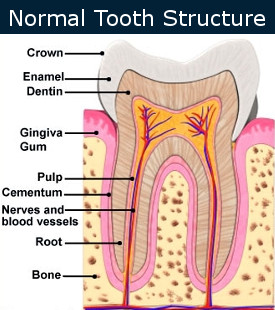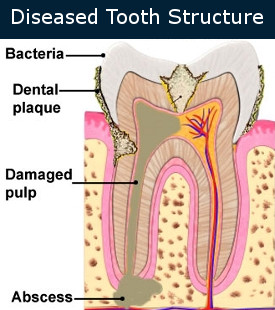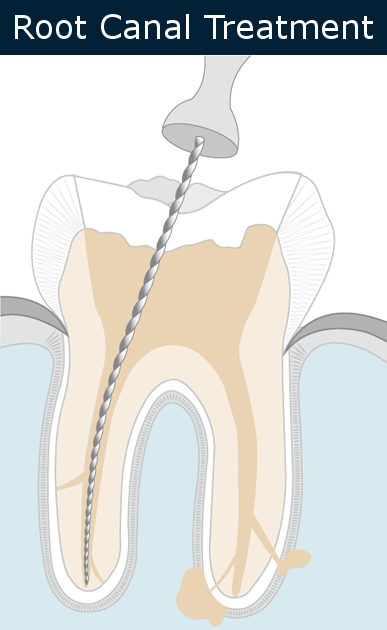Root Canal Burbank
Root canal treatment is an important stage in the preservation of teeth. The treatment procedure involves removing the damaged area of the tooth, cleaning it and then filling and sealing it.
When Is Root Canal Treatment Needed?
It’s important to visits the dentist if you develop a toothache. If your tooth is infected, the pulp can’t cure by itself. It is very dangerous and risky to leave the infected tooth in your mouth.
Healthy Tooth Structure

At first, it is important to understand the anatomy of the tooth. Tooth crown and tooth roots make up the tooth. The white part that is located above the gum is the crown and the part of the tooth that covered by bone and gum is the root.
The root canal is the part of the tooth in which the dental nerve or pulp is located. The pulp is soft, and fibrous tissue of the tooth, which consists of blood vessels, nerve endings, connective tissue.
When bacteria or products of their vital activity enter the root canal, a reversible or irreversible inflammation of the pulp begins.
What Are the Reasons for Pulp Disease?

The main causes of disease and destruction of pulp are:
- Penetration of bacteria from a deep carious cavity
- Damage to teeth as a result of trauma
- Gum disease
In some cases, pulpitis can develop asymptomatically, without causing unpleasant sensations.
Why Does Tooth Pulp Need to Be Removed?
In the case of an infected and damaged pulp of the tooth, the bacteria begin to multiply. They spread along the nerve to the tips of the roots. Bacteria and their toxins, passing through a hole in the top of the root, often cause infectious damage in deeper tissues.
If you do not treat the inflammation, you can wait for serious complications, the treatment of which becomes difficult and requires great effort. Contact Dr. Sahakyan at My Dentist Burbank to take care of your tooth and preserve them as long as possible.
Symptoms of the Root Canal Therapy:

Primary signs of the need for the root canal treatment are:
- The tooth reacts sharply to cold and hot food.
- Painful sensations during biting or chewing.
- A sharp, aching pain, often arising at night.
- Swelling of the gum near the affected tooth.
- Unpleasant odor from the mouth.
Sometimes, tooth pulp may become diseased or damaged without presenting any symptoms. In these cases, the problem is usually diagnosed by taking X-rays during a dental examination. This is one of the reasons, that you need regular visits to My Dentist Burbank, even if you do not have pain.
Why do You Need to Treat Root Canals?
With a carious process, enamel and dentin are destroyed, bacteria enter the nerve and cause inflammation of the pulp. The nerve dies and becomes a source of infection.
Root canal treatment helps to relieve pain and prevent the further spread of bacteria along the channels towards the bone. This is the procedure for cleaning the root canals from bacteria and the dead nerve.
Advantages of Root Canal Treatment
A root canal treated tooth can function normally and can be maintained with dental care and oral hygiene measures. Advantages of saving the natural tooth with root canal treatment:
- Natural appearance.
- Normal chewing and sensation.
- Protects other teeth from strain.
How Is the Root Canal Treatment Carried?
If you need to treat the root canal of the tooth, first of all, consult Dr. Sahakyan, the best dentist in Burbank, at My Dentist Burbank. For this treatment, a number of procedures are performed.
Root canal treatment consists of the following stages:
- Examination and diagnosis
- Use of anesthesia;
- Access to the inflammation-affected pulp;
- Removal of pulp and dead tissue;
- Filling of root canals.
 Examination and diagnosis – In the first place, the dentist must examine the oral cavity, assess the condition of the affected area and prescribe additional diagnostic measures. Those measures include the execution of X-ray and accurate diagnosis of the tooth. The X-ray allows to establish the length of the pulp chamber and to measure the pain threshold of the nerve. X-rays also show dentists at My Dentist Burbank how complicated the procedure may be.
Examination and diagnosis – In the first place, the dentist must examine the oral cavity, assess the condition of the affected area and prescribe additional diagnostic measures. Those measures include the execution of X-ray and accurate diagnosis of the tooth. The X-ray allows to establish the length of the pulp chamber and to measure the pain threshold of the nerve. X-rays also show dentists at My Dentist Burbank how complicated the procedure may be.
Anesthesia of the tooth- Treatment of the root canals is a completely painless procedure. The treatment is performed under anesthesia. The gel of an anesthetic of high concentration is smeared into the place of needle insertion, so you will not even feel the needle pain.
Providing access to the root canal – Before beginning cleaning of the root canals, the dentist must ensure good access to the root canal. To obtain good access to the area of pulp with dental burs, a straight cavity is created, leading to the root canals.
Cleaning of root canals- The root canals are thoroughly cleaned mechanically and medically. At the stage of root canal cleaning, it is important to remove bacteria, pulpal tissue, which can be infected and dead.
Filling the channels – Before the filling, the final stage of treatment of the tooth canals, the cavities are dried. To determine the length of the channels, the dentist makes a repeated X-ray with the pins inserted into the tooth.
The actual sealing is carried out with pastes based on gutta-percha – a rubber resin with important properties. It is biocompatible with tooth tissues, does not dissolve, retains the shape acquired in the molten state.
With a strong tooth decay, the paste is strengthened with pins to improve the supporting properties of the gutta-percha seal. All inputs to the channels are blocked – this process is called obturation and is necessary to prevent the re-entry of pathogens into the tooth.
Crown filling – The final stage of treatment of the tooth canals is a restoration of the tooth crown form.
What Should You Do After Treatment?
It is important to take good care of your teeth and gums after a root canal treatment. You will need to visit your dentist twice a year for regular dental checkups. It’s also important to keep up a good oral care at home, including brushing twice a day with a toothpaste. After meals use floss and special solutions for mouthwash. Call (818) 578-2332 or contact Dr. Sahakyan at My Dentist Burbank to schedule a complimentary consultation today.
